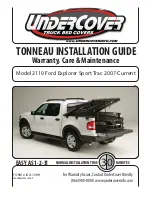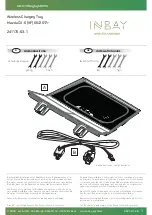
How to Check
Use a good quality pocket-type gage to check tire
pressure. You cannot tell if your tires are properly
inflated simply by looking at them. Radial tires may
look properly inflated even when they are under-inflated.
Check the tire’s inflation pressure when the tires are
cold. Cold means your vehicle has been
sitting for at least three hours or driven no more
than 1 mile (1.6 km).
Remove the valve cap from the tire valve stem. Press
the tire gage firmly onto the valve to get a pressure
measurement. If the cold tire inflation pressure matches
the recommended pressure on the Tire and Loading
Information label, no further adjustment is necessary.
If the inflation pressure is low, add air until you reach the
recommended amount.
If you overfill the tire, release air by pushing on the
metal stem in the center of the tire valve. Re-check the
tire pressure with the tire gage.
Be sure to put the valve caps back on the valve stems.
They help prevent leaks by keeping out dirt and
moisture.
Tire Pressure Monitor System
If your vehicle has the tire pressure monitor system, it
can alert you to a large change in the pressure of
one tire. The system “learns” the pressure at each tire
throughout the operating speed range of your vehicle.
The system normally takes between 45 and 90 minutes
of driving to learn the tire pressures. This time may
be longer depending on your individual driving habits.
Learning need not be accumulated during a single
trip. Once learned, the system will remember the tire
pressures until the system is recalibrated.
After the system has learned tire pressures with
properly inflated tires, the LOW TIRE PRESSURE
message will come on if the pressure in one tire
becomes 12 psi (83 kPa) lower than the other
three tires. The tire pressure monitor system won’t
alert you if the pressure in more than one tire is low, if
the system is not properly calibrated, or if the vehicle
is moving faster than 70 mph (110 km/h).
The tire pressure monitor system detects differences
in tire rotation speeds that are caused by changes in tire
pressure. The system can alert you about a low
tire — but it doesn’t replace normal tire maintenance.
See Tires on page 5-59.
5-66
Summary of Contents for MONTE CARLO 2005
Page 5: ...These are some examples of symbols that may be found on the vehicle v ...
Page 6: ... NOTES vi ...
Page 17: ...Put someone on it Get it up to speed Then stop the vehicle The rider does not stop 1 11 ...
Page 110: ... NOTES 2 48 ...
Page 113: ... NOTES 3 3 ...
Page 114: ...Instrument Panel Overview 3 4 ...
Page 204: ... NOTES 3 94 ...
Page 260: ...When you open the hood on the 3800 V6 Code K engine you will see the following 5 14 ...
Page 352: ... NOTES 5 106 ...
















































